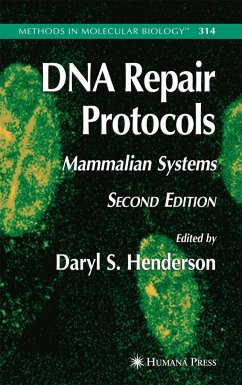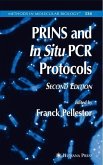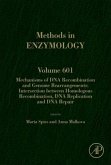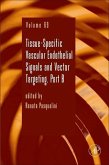This collection of readily reproducible techniques for repairing mammalian DNA contains fourteen entirely new chapters and many extensively revised chapters. The methods presented cover cytogenetic analysis, measuring the cellular response to ionizing radiation, detecting single-strand (nicks) and double-strand DNA breaks, detecting the presence of 'adducted' bases in DNA, and preparing mismatch repair (MMR) plasmid substrates. Among the highlights are excellent coverage of both base excision repair (BER) and nucleotide excision repair (NER), useful assays for identifying and quantifying UV-induced DNA lesions and DNA breakage, gene therapy, environmental mutagenesis and cancer, and gene targeting.
"...It will serve as an essential reference for both the practical and theoretical aspects of DNA repair studies, encourage the transfer of methodologies between model systems, and stimulate the development of new approaches." - Anticancer Research"...must for any science library supporting a molecular biology program." - E-Streams"An informative collection of techniques and protocols for characterizing and utilizing DNA repair activities and enzymes from some of the leading names in DNA repair field. This collection of protocols is ideal for both the novice in the field and to the experienced applied researcher." - Lavoisier Librairie
"...an extremely useful resource for any laboratory with an interest in the vibrant field of DNA repair. Any good laboratory manueal should be not only a useful reference guide but also a source of inspiration, and it is undoubtedly true that DNA Repair Protocols: Mammalian Systems succeeds on both counts." -Int. J. Radiation Oncology Biol. Phys.
"This is the definite book on the subject not only for those working in the field of DNA repair but also for those interested in genetic toxicology and chemical safety." -BTS Newsletter
"...an extremely useful resource for any laboratory with an interest in the vibrant field of DNA repair. Any good laboratory manueal should be not only a useful reference guide but also a source of inspiration, and it is undoubtedly true that DNA Repair Protocols: Mammalian Systems succeeds on both counts." -Int. J. Radiation Oncology Biol. Phys.
"This is the definite book on the subject not only for those working in the field of DNA repair but also for those interested in genetic toxicology and chemical safety." -BTS Newsletter
"...a comprehensive series of technique-oriented chapters focusing on eukaryotic DNA repair methodology. ...this text succeeds admirably...The scope of the text is fairly broad and encompasses not only in vitro biochemistry and enzymology, but also cell biology and genetics and even signal transduction....In vitro biochemical assays are well covered,...A particularly nice feature of the book is that the chapters have undergone uniform editing and formatting. All provide a nice overview of the topic, including a brief review of the pertinent literature, followed by step-by-step methods sections. The methods are clearly presented in annotated outline form with cross referencing and high level of detail. Each chapter has a particularly valuable section at the end, called "Notes" in which the authors present some of the nitty-gritty details and tricks of the trade needed to make the techniques work....Overall, this book should provide a valuable laboratory companion for researchers in the area of DNA repair. It serves to provide useful and readable introductions to various topics, along with techniques protocols sufficient for reproducibility....this text will have substantial appeal to the readers of Radiation Research."-Radiation Research
"The list of authors contains many of the leading scientists within the field...Protocols for most experimental eukaryotic organisms are described, from yeast through plants, worms, flies and frogs to mammals. Another laudable quality of this book is the standardization of the descriptions in Materials and methods. Since (almost) all articles are organized similarly, it is relatively easy to find what you want. Also, technical details have been standardized....At the end of each article , there is a 'Notes' section with detailed explanation of specific technical points. For a novice it is good to be reminded that ethidium bromide is a mutagen and that lids should be loosened before putting flasks in the microwaveoven. Iparticularly liked the description, written by the editor, of how to squash Drosophila larvae on a microscope slide by"standing on it with the ball of your foot or your heel. If using the foot method, place the slide (sandwiched in 3 MED MER) on a hard clean floor, cover it carefully with a piece of wood, and stand on that". ...this book keeps up the reputation of the 'Methods in Molecular Biology' series and I would recommend if for labs working with DNA repair, in particular for use by students and technicians."-FEBS Letters
"The list of authors contains many of the leading scientists within the field...Protocols for most experimental eukaryotic organisms are described, from yeast through plants, worms, flies and frogs to mammals. Another laudable quality of this book is the standardization of the descriptions in Materials and methods. Since (almost) all articles are organized similarly, it is relatively easy to find what you want. Also, technical details have been standardized....At the end of each article , there is a 'Notes' section with detailed explanation of specific technical points. For a novice it is good to be reminded that ethidium bromide is a mutagen and that lids should be loosened before putting flasks in the microwaveoven. Iparticularly liked the description, written by the editor, of how to squash Drosophila larvae on a microscope slide by"standing on it with the ball of your foot or your heel. If using the foot method, place the slide (sandwiched in 3 MED MER) on a hard clean floor, cover it carefully with a piece of wood, and stand on that". ...this book keeps up the reputation of the 'Methods in Molecular Biology' series and I would recommend if for labs working with DNA repair, in particular for use by students and technicians."-FEBS Letters








